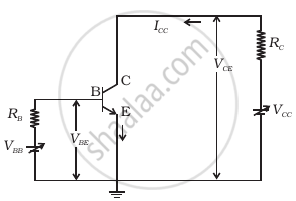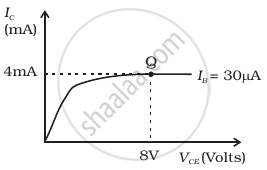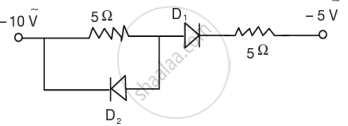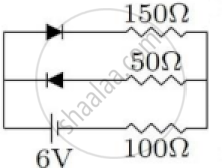Advertisements
Advertisements
प्रश्न
Draw typical output characteristics of an n-p-n transistor in CE configuration. Show how these characteristics can be used to determine output resistance.
उत्तर
Output characteristics is the plot between collector-emitter voltage (VCE) and the collector current (IC) at different constant values of base current (IB).

Output resistance is defined as the ratio of the change in collector-emitter voltage (ΔVCE) to the change in collector current (ΔIC) at a constant base current (IB).
Initially with the increase in VCE the collector current increases almost linearly this is because the junction is not reverse biased. When the supply is more than required to reverse bias the base-collector junction, IC increases very little with VCE.
The reciprocal of slope of the linear part of the curve gives the value of output resistance i.e. `r_0 = ((ΔV_(CE))/(ΔI_C))I_B` .
APPEARS IN
संबंधित प्रश्न
What are α and β parameters for a transistor? Obtain a relation between them.
Write clearly, why in the case of a transistor (i) the base is thin and lightly doped
Write clearly, why in the case of a transistor (ii) the emitter is heavily doped.
Differentiate between three segments of a transistor on the basis of their size and level of doping.
When a p-n-p transistor is operated in saturation region, then its ______.
(A) base-emitter junction is forward biased and base-collector junction is reverse biased.
(B) both base-emitter and base-collector junctions are reverse biased.
(C) both base-emitter and base-collector junctions are forward biased.
(D) base-emitter junction is reverse biased and base-collector junction is forward biased
Draw a typical input and output characteristics of an n-p-n transistor in CE configuration. Show how these characteristics can be used to determine (a) the input resistance (r1), and (b) current amplification factor (β)
The output characteristic curve of a transistor at constant input current is plotted between
Consider the circuit arrangement shown in figure (a) for studying input and output characteristics of npn transistor in CE configuration.
 (a) |
 (b) |
Select the values of RB and RC for a transistor whose VBE = 0.7 V, so that the transistor is operating at point Q as shown in the characteristics shown in figure (b). Given that the input impedance of the transistor is very small and VCC = VBB = 16 V, also find the voltage gain and power gain of the circuit making appropriate assumptions.
If an emitter current is changed by 4 mA, the collector current changes by 3.5 mA. The value of β will be ______.
Sanya performed an experiment of obtaining characteristic curves of a junction diode. When she forward biased it, she found that beyond forward voltage V = Vk, the conductivity is very high. When she reverse biased the diode she found that a very small current (of about a few microamperes) flows in the diode. It remained constant even though she varied the voltage.
(i) In Figure 1 below, which one of the diodes is forward biased?

Figure 1
(ii) What is meant by a saturation current?
(iii) When applied voltage during forward bias is small, why does no current flow in the diode?
(iv) The circuit shown in Figure 2 below contains two diodes, each with a forward resistance of 50 Ω and with infinite resistance during reverse bias. If the battery voltage is 6V, then calculate the current through the 100 Ω resistance.

Figure 2
